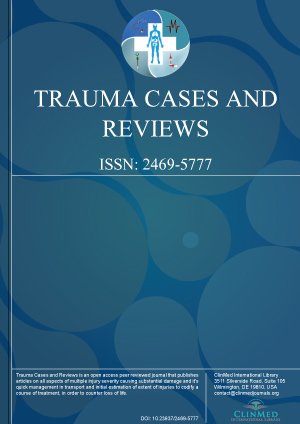Open Access DOI:10.23937/2469-5777/1510090
Timeline of Cross Finger Flap: From its Inception to its Future
Sourabh Shankar Chakraborty, DNB, MNAMS, Sudeshna Acharya, MBBS, Manojit Midya, MS, MCh and Ranjit Kumar Sahu, MS, MCh, FCLS
Article Type: Review Article | First Published: April 07, 2021
Since the first description of the cross-finger flap in 1950 for finger injury defect cover, over the last 70 years it has been tremendously explored and has underwent innumerable refinements and modifications. Whether used alone or in combination with other flaps for the reconstruction of finger defects, traumatic or non-traumatic, cross finger flap has proven its worth as a workhorse for finger reconstruction. Despite a handful of innate disadvantages, it has given excellent sensory, functiona...
Open Access DOI:10.23937/2469-5777/1510089
Traumatic Brachiocephalic Artery Pseudoaneurysm
Sally Shepherd and Jessica Wong
Article Type: Case Report | First Published: March 13, 2021
A 19-year-old female presented to a tertiary Trauma Centre post intentional 100 km/hr motor vehicle crash into a tree. She was wearing a seatbelt in the driver's seat, airbags were deployed and required assistance extricating after entrapment for 45 minutes. She was normotensive but tachycardic with a shortened and rotated right lower limb, receiving 500 mls crystalloid and splinting to her right lower limb. On arrival in ED her airway was patent and cervical spine secured in a rigid collar. She...
Open Access DOI:10.23937/2469-5777/1510088
Tongue-Type Calcaneal Fracture due to a Low-Energy Injury
Filipa Vilabril, José Vilaça Costa, João Vieira Dias, Rui Migue Cândido and Inês Machado
Article Type: Case Report | First Published: February 17, 2021
Tongue-type fractures are unusual calcaneal fractures that produce an unique and relatively uncommon injury pattern to the bone and soft tissues, due to the separation of the calcaneal tuberosity into superior and inferior fragments. The displacement of the superior fragment has the potential to tent the skin of the posterior heel and, if not treated emergently, partial or full-thickness skin breakdown can progress quickly, and potential necrosis can occur. Early recognition by the emergency phy...
Open Access DOI:10.23937/2469-5777/1510087
A Case Report of Negative Pressure Wound Therapy in Post- Traumatic Raw Area
Naim Sulaiman Abuzarifa and Wan Azman Wan Sulaiman
Article Type: Case Report | First Published: January 30, 2021
Traumatic wounds vary from abrasions and minor skin incisions or tears to wounds with extensive tissue damage or loss and damage to bone and internal organs. The use of economic negative-pressure wound therapy for managing wounds and negative-pressure wound therapy is known for improving a wide range of acute and chronic wounds. This medical device involves applying a wound dressing through which negative pressure is applied and wound discharges drawn out from the wound. The treatment aims to pr...

